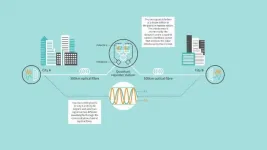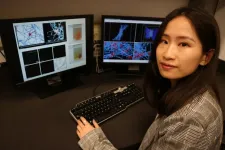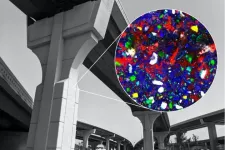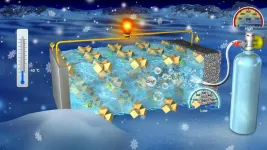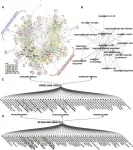(Press-News.org) The emerald ash borer, an invasive beetle native to Southeast Asia, threatens the entire ash tree population in North America and has already changed forested landscapes and caused tens of billions of dollars in lost revenue to the ash sawtimber industry since it arrived in the United States in the 1990s. Despite the devastating impact the beetle has had on forests in the eastern and midwestern parts of the U.S., climate change will have a much larger and widespread impact on these landscapes through the end of the century, according to researchers.
"We really wanted to focus on isolating the impact of the emerald ash borer on biodiversity, forest composition, biomass and other factors," said Stacey Olson, program coordinator and legal assistant at Resources Legacy Fund. Olson completed the research as part of her master's thesis at Penn State. "We found that emerald ash borer and its impact on ash trees has serious implications for forest change at the site level, but at the broad landscape level, the climatic changes over the next century were much more important in terms of forest composition and species diversity."
The researchers used a forest simulation model to examine the effects of the emerald ash borer and climate change on a forested area of northeast Wisconsin through the year 2100. The area includes the Menominee Reservation. The Menominee Indian Tribe of Wisconsin has been sustainably harvesting timber from the forest for more than 150 years. The scientists reported their findings in the journal Ecosystems.
The model took into account how trees grow, disperse seeds, die and interact with disturbances such as climatic changes. It also accounted for emerald ash borer infestation and pre-emptive ash tree removal, an Indigenous forest management strategy.
"When we run the model, all of these components work simultaneously and interact with one another across the landscape and across time," said Olson, who was also an Environmental Scholar in the Earth and Environmental Systems Institute (EESI) at Penn State. "The model gives us a picture of what all these interacting disturbance and succession processes look like."
The researchers looked at moderate and high-level climate change scenarios based on a business-as-usual approach that fails to curb greenhouse gas emissions within the next decade. The landscape itself partly drove the team's decision to study these scenarios, Olson said. The forest sits in what scientists call a tension zone, where vegetation, soil type and climate variability can shift quickly as one moves across the landscape. In these areas, changes in climate can result in drastic changes on the ground.
The model showed a shift in the types of trees present in the study area by 2100. Northern hardwoods, like beech and birch trees, decreased by approximately 12%, to 35% of the total biomass of all species in the forest. Under climate change conditions, southern hardwoods, like black cherry trees, increased from 4% to 23% by mid-century and became the dominant species in the southern part of the study area.
The model showed that in some areas, the emerald ash borer would completely remove ash trees, clearing the way for other species to replace them. Ash, however, is not the dominant species in the forest, and its removal cannot account for the large shift in tree composition from northern to southern hardwoods. The researchers attributed this shift to climatic changes, such as warmer temperatures and periods of drought or water scarcity, identified in the models.
The study led by Olson is part of a larger project, Visualizing Forest Futures (ViFF), led by Erica Smithwick, distinguished professor of geography and EESI associate, and done in collaboration with the Menominee. The project combines Indigenous forest-management practices with cutting-edge modeling and visualization techniques to better understand the connections between human values and forests and how to sustainably manage forest resources.
"Our project seeks to guide decision-making about forest management strategies while also accounting for uncertainties in forest changes under future climates," Smithwick said. "Stacey's paper provides key information to help guide that process."
The team's research demonstrates the importance of focusing more resources on climate change mitigation rather than on a very specific, targeted threat like the emerald ash borer.
"Some of the research I found said that the ash will likely become functionally extinct within the next couple of decades," said Olson. "While this is clearly a serious problem that deserves attention, a big takeaway for me is that climate is an even larger driver of forest change over the next century, and addressing these challenges must be a top priority."
INFORMATION:
Also participating in this research were Melissa Lucash, University of Oregon; Robert Scheller, North Carolina State University; Robert Nicholas, Penn State; Kelsey Ruckert, RPS Ocean Science and formerly a scientific programmer at Penn State when the research was conducted; and Christopher Caldwell, College of Menominee Nation.
The National Science Foundation; NASA Pennsylvania Space Grant Consortium; and Penn State, through EESI, the Center for Landscape Dynamics, the E. Willard Miller Award in Geography, the Herbert and Mary B. Hughes Fund and the Department of Geography, supported this research.
An experimental, lab-made antibody can completely prevent nonhuman primates from being infected with the monkey form of HIV, new research published in Nature Communications shows.
The results will inform a future human clinical trial evaluating leronlimab as a potential pre-exposure prophylaxis, or PrEP, therapy to prevent human infection from the virus that causes AIDS.
"Our study findings indicate leronlimab could be a new weapon against the HIV epidemic," said the study's lead researcher and co-corresponding author of this paper, Jonah Sacha, Ph.D., an Oregon Health & Science University professor at OHSU's Oregon National Primate Center and Vaccine & Gene Therapy Institute.
"The results of this pre-clinical ...
Cambridge, UK, 7th June 2021: The Cambridge Research Laboratory of Toshiba Europe today announced the first demonstration of quantum communications over optical fibres exceeding 600 km in length. The breakthrough will enable long distance quantum-secured information transfer between metropolitan areas and is a major advance towards building the future Quantum Internet.
The term Quantum Internet describes a global network of quantum computers connected by long distance quantum communication links. It is expected to allow the ultrafast solution of complex optimization problems ...
An international group of researchers has developed a new technique that could be used to make more efficient low-cost light-emitting materials which are flexible and can be printed using ink-jet techniques.
The researchers, led by the University of Cambridge and the Technical University of Munich, found that by swapping one out of every one thousand atoms of one material for another, they were able to triple the luminescence of a new material class of light emitters known as halide perovskites.
This 'atom swapping', or doping, causes the charge ...
Heart attacks and strokes -- the leading causes of death in human beings -- are fundamentally blood clots of the heart and brain. Better understanding how the blood-clotting process works and how to accelerate or slow down clotting, depending on the medical need, could save lives.
New research by the Georgia Institute of Technology and Emory University published in the journal Biomaterials sheds new light on the mechanics and physics of blood clotting through modeling the dynamics at play during a still poorly understood phase of blood clotting called clot contraction.
"Blood clotting is actually a physics-based phenomenon that must occur to stem bleeding after ...
The concrete world that surrounds us owes its shape and durability to chemical reactions that start when ordinary Portland cement is mixed with water. Now, MIT scientists have demonstrated a way to watch these reactions under real-world conditions, an advance that may help researchers find ways to make concrete more sustainable.
The study is a "Brothers Lumière moment for concrete science," says co-author Franz-Josef Ulm, professor of civil and environmental engineering and faculty director of the MIT Concrete Sustainability Hub, referring to the two brothers who ushered in the era of projected films. Likewise, Ulm says, the MIT team has provided a glimpse of early-stage cement hydration that is like cinema in Technicolor ...
A new technology could dramatically improve the safety of lithium-ion batteries that operate with gas electrolytes at ultra-low temperatures. Nanoengineers at the University of California San Diego developed a separator--the part of the battery that serves as a barrier between the anode and cathode--that keeps the gas-based electrolytes in these batteries from vaporizing. This new separator could, in turn, help prevent the buildup of pressure inside the battery that leads to swelling and explosions.
"By trapping gas molecules, this separator can function as a stabilizer for volatile electrolytes," said Zheng Chen, a ...
To describe something as slow and boring we say it's "like watching grass grow", but scientists studying the early morning activity of plants have found they make a rapid start to their day - within minutes of dawn.
Just as sunrise stimulates the dawn chorus of birds, so too does sunrise stimulate a dawn burst of activity in plants.
Early morning is an important time for plants. The arrival of light at the start of the day plays a vital role in coordinating growth processes in plants and is the major cue that keeps the inner clock of plants in rhythm with day-night cycles.
This inner circadian clock helps plants prepare for the day such as when to make the best use of sunlight, the best time to open flowers ...
Citizen opposition to COVID-19 vaccination has emerged across the globe, prompting pushes for mandatory vaccination policies. But a new study based on evidence from Germany and on a model of the dynamic nature of people's resistance to COVID-19 vaccination sounds an alarm: mandating vaccination could have a substantial negative impact on voluntary compliance.
Majorities in many countries now favor mandatory vaccination. In March, the government of Galicia in Spain made vaccinations mandatory for adults, subjecting violators to substantial fines. Italy has made vaccinations mandatory for care workers. The University of California and California State University systems announced in late April that vaccination ...
ITHACA, N.Y. - Building lights are a deadly lure for the billions of birds that migrate at night, disrupting their natural navigation cues and leading to deadly collisions. But even if you can't turn out all the lights in a building, darkening even some windows at night during bird migration periods could be a major lifesaver for birds.
Research published this week in PNAS found that over the course of 21 years, one building sustained 11 times fewer nighttime bird collisions during spring migration and 6 times fewer collisions during fall migration when only half of the building's windows were illuminated, compared ...
Many mainstream depictions of immigration at the southern border of the United States paint a dark picture, eliciting imagery of violent gang members and child trafficking. But how many undocumented immigrants are really involved in this kind of activity? Many people may be surprised to learn the answer is far fewer than they think.
A new study from the Peace and Conflict Neuroscience Lab (PCNL) at the Annenberg School for Communication found that Americans dramatically overestimate the number of migrants affiliated with gangs and children being trafficked, and that this overestimation contributes to dehumanization of migrants, lack of empathy for their suffering, and individuals' views on immigration policy. In addition, the researchers developed and tested interventions to ...
